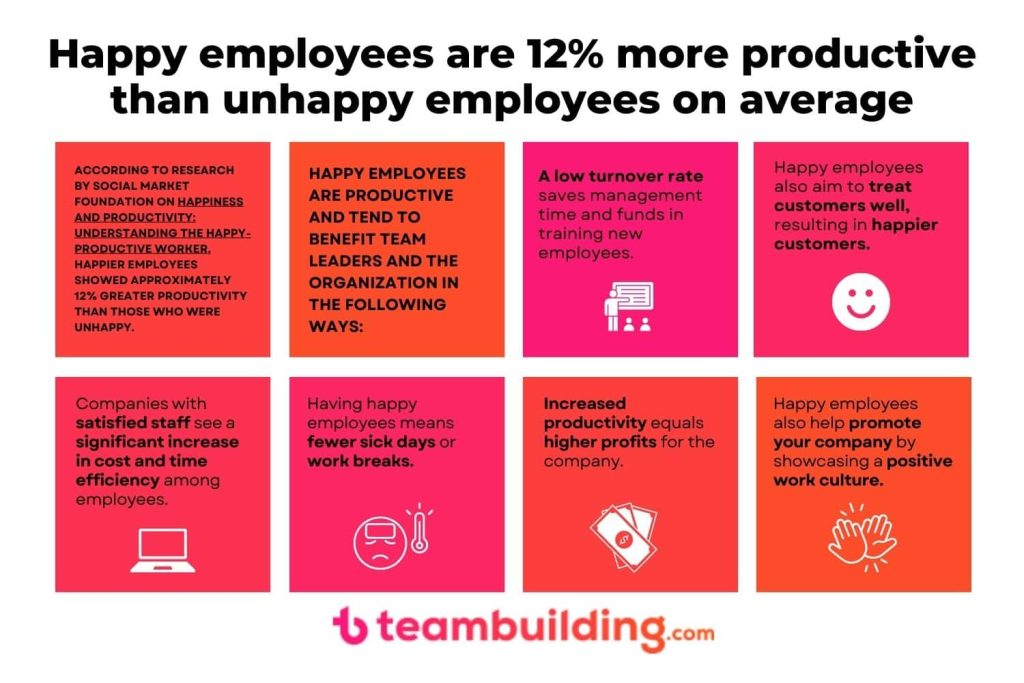10 Productivity Improvement Techniques For Your Company
- Updated on: February 3, 2025
Dedication to productivity improvement and effective employees goes hand in hand with having a profitable company. If a company can find and hire employees who knock it out of the park and are productive most of the time, they have struck gold.
Companies should try their best to hire productive employees who produce a significant amount of work. Unfortunately, studies show that employees are only productive for 2 hours and 23 minutes of their workday. Once an employee becomes distracted, it takes them an average of 23 minutes to refocus
Understandably, these statistics may sound a little crazy to you. However, think back to how many times you have been walking around an office and seen employees chatting, getting coffee, or on their phones.
These glimpses you catch are a direct reflection of your employee’s productivity. The average American spends 5.4 hours on their phone daily. So, it should not be a surprise that this is a huge time drain for all employees.
In this article, we will dive into 10 productivity improvement strategies your company needs to try to drive success across the board by boosting productivity.
Luxafor Flag busy light
What Is a Productive Employee?
Knowing what makes an employee productive is key to understanding how you can have a productive employee. A productive and positive employee will have excellent time management and organization skills. This will allow them to be an engaged and productive employee.
Additionally, learning to source the right talent will allow your company to find people who will bring your company success and take it to the next level. This will foster an environment that allows productivity to flow and ensures employees are happy.
Do you want to build and maintain new habits? Get your free PDF version of the Don't Break The Chain calendar and start today!
Do you want to build and maintain new habits? Get your free PDF version of the Don't Break The Chain calendar and start today!
What is Productivity Improvement?
Productivity improvement is a systematic effort and strategy to improve efficiency and performance. It involves identifying and implementing changes in processes and behaviors. It will help achieve better results with the same or fewer resources.
It’s also a dynamic process that requires continuous evaluation and adaptation. This commitment will refine strategies for better outcomes.
Productivity improvement is not about working harder; it’s about working smarter. It is a holistic approach that considers processes that contribute to an organization’s success.
Here are 7 common forms of productivity improvement:
#1 Process Automation
Automating repetitive and manual tasks using technology can significantly improve productivity. This can include automating data entry, document processing, and routine administrative tasks.
#2 Lean Management
Lean principles cut waste, optimize processes, and maximize value. Companies can streamline operations by identifying and eliminating unnecessary steps, delays, and inefficiencies.
#3 Six Sigma
Six Sigma is a popular continuous improvement process, especially in manufacturing. It aims to reduce defects and variations in processes to improve efficiency. It involves data-driven analysis, process optimization, and continuous improvement to achieve better results.
#4 Performance Metrics and Key Performance Indicators
Setting and tracking performance metrics and KPIs is important. It helps companies track progress, identify areas for improvement, and make data-driven decisions.
#5 Employee Engagement Initiatives
Engaged employees are more motivated and committed to their work. Employee engagement programs enhance job satisfaction, leading to higher levels of productivity.
#6 Continuous Improvement Culture
Fostering a culture of continuous improvement is key to success. It encourages employees to seek ways to consistently enhance processes and workflows.
#7 Workplace Well-being Initiatives
Prioritizing employee well-being through wellness programs, stress reduction activities, and mental health support. This can lead to higher levels of focus, creativity, and productivity.
The most effective productivity improvement will vary based on a company’s specific needs. Tailor them to your company’s unique context and track their impact to ensure success in the long run.
10 Productivity Improvement Strategies Your Company Needs to Try
Now that we know what a productive employee is and what improvement strategies are, let’s take a look at some productivity improvement strategies your company needs to try.
1. Set Clear Goals and Priorities
Establishing clear and achievable goals for your employees provides a sense of direction and purpose. Focus on tasks based on their impact and align them with your business objectives.
If your employees know what they should be accomplishing, this should help them to focus on the needs of the company. It will also help them not be as easily distracted by external factors.
2. Put Agile Methodologies in Place
Agile methodologies, like Scrum and Kanban, promote flexibility, collaboration, and incremental progress.
Scrum is project management and enterprise software development. It is designed to enhance collaboration and the ability to respond to changing requirements. Scrum is particularly effective for complex projects that need continuous development and improvement.
Kanban is a visual project management framework. It emphasizes visualizing work, limiting work progress, and optimizing workflow. It began with Toyota and was initially used in manufacturing to improve production processes. But, it has since been adopted and adapted for various industries.
Both these methodologies empower teams to adapt to changes quickly, which will improve efficiency.
3. Embrace Technology
When it comes to productivity, technology is your friend. Leverage technology tools such as project management software, communication platforms, and automation tools. These will streamline processes, cut manual tasks, and enhance communication across teams. The service desk software can boost the productivity of the customer service team by automating repetitive tasks.
Luxafor helps employees take their productivity to the next level with Luxafor Bluetooth. This wireless do not disturb LED light is perfect for letting coworkers know when an employee is in focus mode. The color schematics of the device are a signal to other employees when they should hold off on non-urgent questions.
This device allows focused employees to stay in the productivity zone and create their best work.
4. Offer Flexible Work Arrangements
Being flexible with work hours and other factors allows employees to work at their time and pace. This directly affects employee productivity. Employees who are not distracted by the busyness of life can focus on their work better.
Companies should offer flexible work arrangements, like remote work or flexible hours. This will increase employee satisfaction and reduce commute stress. Both these things will provide a better work-life balance and increased productivity.
If a company is concerned that employees may not be as productive at home, they can set up remote employee monitoring to set their mind at ease. This will allow the company to rest assured they made the right decision in providing flexible work arrangement options.
5. Provide Ongoing Training
A happy employee is a trained employee. Invest in continuous learning and development for your employees.
Consider providing training on various options. Building client relationships, time-saving opportunities, and mental health breaks are some great examples.
Offering training throughout the year will motivate your employees to be productive as well-trained employees are more confident in their roles which leads to improved efficiency and better problem-solving.
6. Promote Open Communication
Be sure to create an environment where open and transparent communication is encouraged and, subsequently, fosters collaboration, idea-sharing, and efficient problem-solving among team members.
If your company still needs to put something in place, set up a way for employees to produce feedback. This will help your company take action toward improvement. A great way to do this is to use a free QR code on a flier to capture insight into what employees think of current strategies.
After receiving responses to the survey, share what changes are being implemented. This practice will encourage and motivate their work since they know the communication lines are open, and any issues that may arise will be worked on. Also, create an open atmosphere where employees can interact and create a bond. You can try using a company wide business cards by Uniqode to share information of each other and connect effortlessly.
7. Use the Pomodoro Technique
The Pomodoro Technique involves breaking work into intervals (usually 25 minutes) followed by a short break.
Instead of employees sitting down and trying to focus for hours on end, they can break up their work day. This technique will let them have hyper-concentrated productivity segments coupled with essential mental breaks. Employees will maintain focus and prevent burnout by using short bursts of high productivity.
8. Reduce Unnecessary Meetings
Reduce the number of meetings and ensure they are purposeful and well-structured. Unproductive meetings can consume valuable time and hinder actual work progress.
Allow your employees to decide whether they are needed in a meeting. Sometimes, employees may find themselves in a meeting where they do not need to be. Allow them the flexibility to excuse themselves and return to their normal work.
9. Embrace the Power of Delegation
Empower your employees by delegating tasks according to their strengths and expertise. Learning how to delegate is key to increased productivity.
It not only lightens your workload but also boosts the skills and confidence of your team members.
10. Create a Comfortable Work Environment
Design an ergonomic workspace that promotes comfort and productivity. Proper lighting, comfortable seating, and clutter-free spaces contribute to a conducive work environment.
If possible, provide a room where employees can have a mental break and follow relaxation tips. Employees will have a much-needed mental break during the hustle and bustle of the week.
Why Should a Company Increase Productivity?
Increasing productivity is key to a company’s sustained growth and competitiveness. A surprising study found that the typical office worker gets interrupted, on average, every three minutes and five seconds.
If a company can find a way to cut distractions and empower employees to be productive, they will be on their way to achieving greater financial stability. This will allow them to focus on strategic initiatives which will help build a foundation for long-term success in a dynamic business landscape.
Final Thoughts on Productivity Improvement Strategies
Improving productivity requires dedication and a willingness to explore new approaches. These 10 productivity improvement strategies can help your company create a work environment that fosters efficiency. In our company, we have developed a system of assessment for the performance of a particular task for each division. This way we understand the real workload of the team and each employee. It also helps employees to better plan their time and workload – Victor Karpenko, CEO at SeoProfy.
Remember, there is no one-size-fits-all solution. Tailoring these strategies to your company’s unique needs and goals is important. As you work towards boosting productivity, you’ll pave the way for a more thriving business.
Want to take your productivity improvement strategies to the next level? Find out how Luxafor can help!
LUXAFOR HELPS PEOPLE TO ACHIEVE THEIR GREATEST PRODUCTIVITY LEVELS WITH A WIDE VARIETY OF OFFICE PRODUCTS. LET’S BE PRODUCTIVE TOGETHER!
Frequently Asked Questions
Productivity is the measure of output relative to input. It's about achieving more with less effort and wasted time.
Increased productivity leads to better results, improved time management, reduced stress, and a sense of accomplishment.
Track your completed tasks, time spent on activities, or use project management tools to analyze efficiency.
Do you want to build and maintain new habits? Get your free PDF version of the Don't Break The Chain calendar and start today!
Do you want to build and maintain new habits? Get your free PDF version of the Don't Break The Chain calendar and start today!
Author






















